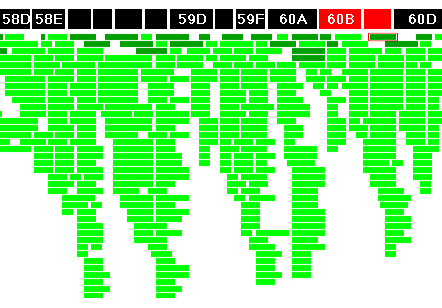Searches
ArmView: Chromosome Arm Map Viewer
BAC STS Map .. | .. P1 STS Map .. | .. How to use ArmView .. | .. Credits
ArmView: View STS Content Maps by Chromosome Arm 
ArmView is a Java applet that allows you to navigate the BDGP BAC and P1 maps. For more information on the applet, see How to Use ArmView. ArmView also lets you search the Berkeley Fly Database for other cytologically mapped objects. To learn more about this feature, see How To Search by Region.
BAC STS Content Map - (Release 3.2, 23 Mar 2000)
**The construction of the BAC map is an ongoing project**. While it is largely accurate, it will continue to be refined especially in regions near the centromeres. Moreover, we sometimes do not have sufficient data to determine the order of adjacent STSs. Refer to the genome sequence for reliable local STS order.Information about obtaining BAC clones and high-density filter arrays can be obtained at /about/materials.
To construct the BAC map of chromosomes 2 & 3, we used 1226 STS markers derived from the P1 map, 690 derived from the ends of the BAC clones themselves, and 7 derived from other sources. The end sequences of over 12,000 BACs from the RPCI-98 library were determined in collaboration with Genoscope and have been deposited in the EMBL and GenBank sequence databases; the Berkeley Fly database HTML reports for individual BAC clones also show these sequences when available.
We carried out STS content mapping by filter hybridization to high-density arrays of the RPCI-98 BAC library. These data were assembled using SEGMAP and then manually edited. The BAC map is considerably improved over the P1 map in its coverage, average contig size and accuracy. The P1 map of chromosomes 2 & 3 (96.8 Mb) was comprised of 348 contigs of average size ~300kb. The major autosomes are now covered by 9 BAC contigs with only two small gaps outside of the repeat-rich regions near the centromeres. A set of 10,000 of the BACs in the library (~13-hit) have been restriction fingerprinted with Eco RI at the BDGP's Baylor site (see http://www.hgsc.bcm.tmc.edu/drosophila/mapping/). Our Cytogenetics Core is mapping a tiling path of BACs by in situ hybridization to polytene chromosomes (in situ results are displayed in ArmView).
-
The BAC map of chromosomes 2 & 3 is described in Hoskins et al. 2000 and can be viewed using our Java map viewer ArmView.
-
A BAC map of the X chromosome produced by the EDGP can be viewed at [HERE].
-
A BAC map of chromosome 4 produced in the laboratory of Ross Hodgetts is described in Locke et al. 2000.
P1 STS Content Map
The P1 map was constructed using STS-mapping and polytene localization data for individual P1 clones. The construction of the P1 map is described in [Kimmerly et al. 1996](/about/pubs/index.html#genomics).How to Use ArmView
Detailed instructions on using ArmView and configuring your system most efficiently for Java applets can be found here: [How to Use ArmView]
Credits
Roger Hoskins directs the BDGP physical mapping group. Lisa Ciesiolka and Mohammed Naeemuddin did the laboratory work to produce STS content data used to construct the map. Ben Berman provided informatics support, and Catherine Nelson edited and curated the map assemblies. Todd Laverty is mapping BACs in a tiling path by in situ hybridization to polytene chromosomes. Others who contributed include Reed George, Suzanna Lewis, Sue Celniker and Gerry Rubin.
The map shown here was generated by STS-content mapping and polytene in situ hybridization. The BDGP's Baylor College of Medicine site has used Eco RI restriction fingerprinting to help construct and verify the map. By fingerprinting a complete tiling path of BAC clones we hope to ensure that any clone that contains a deletion and thus does not accurately represent the genome is eliminated. Steve Scherer and Richard Gibbs have managed this work and these data are available at http://www.hgsc.bcm.tmc.edu/drosophila/mapping.
Ann Loraine wrote the map viewer software using display components developed in collaboration with Neomorphic Software. Ben Berman, Gregg Helt, Suzanna Lewis, and Gerry Rubin also contributed code, design work or both.
